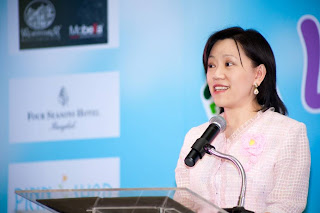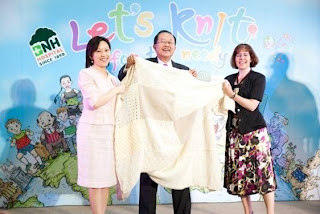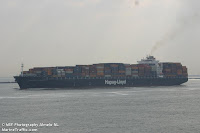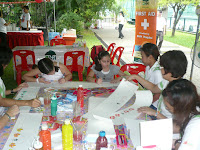Weaving the way to the Moon
By Jonathan Fildes
Science and technology reporter, BBC News
As Apollo 11 sped silently on its way to landing the first men on the Moon, its safe arrival depended on the work of a long-haired maths student fresh out of college and a computer knitted together by a team of "little old ladies".
Now, 40 years after Apollo 11 landed Neil Armstrong and Buzz Aldrin on the Moon, the work of these unsung heroes who designed and built the Apollo Guidance Computer (AGC) is back in the spotlight.
"I wasn't so aware of the responsibility at the time - it sort of sunk in later," said Don Eyles, a 23-year-old self-described "beatnik" who had just graduated from Boston University and was set the task of programming the software for the Moon landing.
"I don't recall the risk and the responsibility and the fact that other people's lives were to some extent in our hands."
But if Mr Eyles embodied the young, can-do attitude of many of the 400,000 people who are estimated to have worked on the Apollo programme, the "little old ladies" epitomised a more cautious approach.
“ Why was onboard navigation a basic requirement for Apollo? Well, because the Russians might not play fair ”
Richard Battin
Director of the AGC project
The team of ex-textile workers and watch-makers were employed by defence firm Raytheon to "weave" the software into the memory of the computer.
"The astronauts toured the production facilities and got people to realise that it was real and they were real," explained Eldon Hall, designer of the AGC.
"The little old ladies said: 'that could be my son so I am going to do my job as well as I can'."
Computer Jam
The AGC was a first-of-its-kind device that would become the forerunner of all "fly-by-wire" aircraft systems and the computer that would land man on the Moon.
"The computer was tiny compared to the one in your cell phone," said Mr Eyles. "Tiny in every dimension except size."
The one cubic-foot-sized machine had the equivalent of 160 kilobytes of memory and could do a very simple addition in 24 microseconds.
"That may sound very fast, but compared to modern computers that's extremely slow," said Mr Eyles. "You have to understand that anything the computer did was made up of thousands if not millions of instructions."
Although relatively lethargic and cumbersome, Nasa realised early on that an onboard digital computer was the only way to guarantee success.
"Why was onboard navigation a basic requirement for Apollo? Well, because the Russians might not play fair. They might jam communications," Dr Richard Battin, director of the AGC project, recently told a conference.
In addition, the missions were so complex that the fledgling space agency could see no other way for the astronauts to reach the Moon.
"The pilots could not fly the thing… even though they kept thinking they would," explained Mr Hall.
In fact, some engineers thought that any intervention from the astronauts was completely unnecessary.
"From our point of view the guidance system could be completely without the pilot," Mr Hall told BBC News.
The contract to build the system - between the Massachusetts Institute of Technology and Nasa - was the first of the Apollo programme and was signed just 76 days after JFK outlined his plans, highlighting the importance placed on the machine.
But Mr Hall remembers that many remained sceptical that it would work.
“ One you get it wired it's not going to change without breaking those wires ”
Eldon Hall
"The biggest problem was convincing people that a computer could be reliable," he said. "That was harder than designing it."
In the 1960s most computers were still housed in their own building and required huge amounts of power and frequent repairs.
In contrast, the AGC had to be small, lightweight, never fail and consume less power than a 60 watt light bulb. It also had to be designed and built in eight years or less by a team that were themselves grappling with new ideas.
"I only heard the word 'digital' once through my entire time at university," admitted Mr Hall.
But the MIT lab had a long history of designing instrumentation for weapons and aircraft and it was felt that the team of engineers were up to the task.
Early on, the constraints of the size and the requirements of the computer forced the team to make some bold decisions.
One of these was to use a fledgling technology known as integrated circuits - today, more commonly known as silicon chips. The first working circuit had only been shown off in 1958.
"It was an extremely courageous decision that was probably vital to the success of the mission," said Mr Eyles.
To simplify the design and manufacture - and, crucially, minimise the risk of failure - the computer used just one type of circuit.
The decision also ensured that the fast-changing silicon industry had an incentive to continue to produce the chips for the whole of the Apollo programme.
"The whole field was changing so rapidly that it was almost a suicide risk to choose one and use that thing to fly to the Moon 10 years later but that's what we had to do," said Mr Hall.
However, the entire computer was not so hi-tech. In order to make sure that the software was robust it was "woven" into so-called "rope core memories".
These used copper wires threaded through or around tiny magnetic cores to produce the ones and zeroes of binary code at the heart of the software.
Pass the copper wire through the core and the computer read it as a one. Pass it around and it was read as a zero.
"Once you get it wired it's not going to change without breaking those wires," said Mr Hall.
The rope core memories would become know as "LOL memory" after the "little old ladies" who knitted together the software at a factory just outside Boston.
These ladies would sit in pairs with a memory unit between them, threading metres and metres of slender copper wires through and around the cores.
"It's an extremely time-consuming process and it meant that the programs had to be finished and fully tested months in advance," said Mr Eyles.
“ It's only now with the perspective of 40 years that Apollo stands out as a unique event, probably never to be repeated in my lifetime ”
Don Eyles
"But it is extremely robust - that information probably still exists despite being left on the Moon."
To ensure reliability and the highest possible standards from the ladies, Nasa also chose to go on a PR mission to the factories.
"We used to go to the cafeteria and the astronauts would come in," said Mary Lou Rogers, one of the ladies who worked on the Apollo line.
"They'd explain the Moon shot and thank us for what a good job we were doing.
"Everybody got all excited when they came in - we were a bunch of married women with children."
However, Nasa did not just leave quality control to good will and chance, said Mrs Rogers, who also worked on Intercontinental Ballistic Missile programmes.
"[Each component] had to be looked at by three of four people before it was stamped off. We had a group of inspectors come in for the Federal Government to check our work all the time."
"It was bad when we worked on Poseidon and Trident. But nothing as bad as when we were on Apollo."
'Spring loaded'
In the end, the attention to detail seemed to have paid off. On 20 July 1969, Neil Armstrong and Buzz Aldrin separated from the command module containing Michael Collins and began their descent to the lunar surface.
But just minutes before Neil Armstrong confirmed to Houston that the "Eagle had landed", the normally cool-headed astronaut was having a slightly more urgent exchange with mission control.
"Program alarm," the ex-fighter pilot called out over the radio.
Armstrong was confronted with a yellow warning light on the AGC, indicating a problem.
"When I heard that the computer was restarting I was very nervous because I thought something serious was going on, really serious," said Mr Hall, who - like 600 million other people - was watching the Moon landing on television.
"I was shaking in my boots. I was very concerned that they would have to abort."
Over the course of the next seven-and-a-half minutes the alarms sounded five more times; the last one went off just 2,000ft above the dusty lunar surface.
Each time Mission Control gave the command to press on with the landing.
Armstrong later explained: "In simulations we have a large number of failures and we are usually spring-loaded to the abort position.
"In the real flight, we are spring-loaded to the land position."
Seven-and-a-half-minutes after the first program alarm, Armstrong uttered the immortal words: "Houston, Tranquility Base here. The Eagle has landed."
But Mission Control had not been reckless. The Apollo Guidance Computer had worked perfectly.
Frantic analysis at MIT and in Houston determined that the alarms stemmed from a mistake in the astronauts' training.
Although not needed for the landing, the rendezvous radar - used when the astronauts returned to the Command Module - was switched on in case the descent had to be aborted at short notice.
The data had overloaded the computer, which dealt with the problem by shedding "low priority tasks" and keeping life-critical functions running.
"The operating system was designed to handle that kind of problem," said Mr Hall.
"The computer was still functioning even though people still say it was failing," he added. "It was saving the mission."
In the end, the AGC and the sometimes-unlikely list of characters who designed and built the machine had succeeded: they had helped land the first men on the Moon and return them safely to Earth.
"It's only now with the perspective of 40 years that Apollo stands out as a unique event, probably never to be repeated in my lifetime," said Mr Eyles.
Story from BBC NEWS:
http://news.bbc.co.uk/go/pr/fr/-/2/hi/technology/8148730.stm
Published: 2009/07/15 18:36:23 GMT
© BBC MMIX
 The 2008 winter season in Thailand was exceptionally cold and many people without adequate clothing in Thailand were unable to keep warm and suffered throughout the cold spell. With this in mind, the BNH Hospital, Bangkok has launched the ‘BNH Let’s Knit 2009’ project to encourage everyone to knit small squares (6” x 6” : 15 cm x 15 cm) which will be sewn together to make warm patchwork blankets for donation before the beginning of the cold weather this 2009 winter.
The 2008 winter season in Thailand was exceptionally cold and many people without adequate clothing in Thailand were unable to keep warm and suffered throughout the cold spell. With this in mind, the BNH Hospital, Bangkok has launched the ‘BNH Let’s Knit 2009’ project to encourage everyone to knit small squares (6” x 6” : 15 cm x 15 cm) which will be sewn together to make warm patchwork blankets for donation before the beginning of the cold weather this 2009 winter. Donated knitted squares can be of any colour, any style (simple garter stitch squares (knit-a-row, knit-a-row) produced on size 6 needles would be perfect). Anyone who isn’t sure how to knit should contact the BNH CRC team for details of when they can receive free tuition at the hospital. Complete squares can be dropped off anytime at the hospital reception or posted to the address shown below. Squares can be sent as soon as completed - the deadline for final donations is 31st October 2009.
Donated knitted squares can be of any colour, any style (simple garter stitch squares (knit-a-row, knit-a-row) produced on size 6 needles would be perfect). Anyone who isn’t sure how to knit should contact the BNH CRC team for details of when they can receive free tuition at the hospital. Complete squares can be dropped off anytime at the hospital reception or posted to the address shown below. Squares can be sent as soon as completed - the deadline for final donations is 31st October 2009.












































